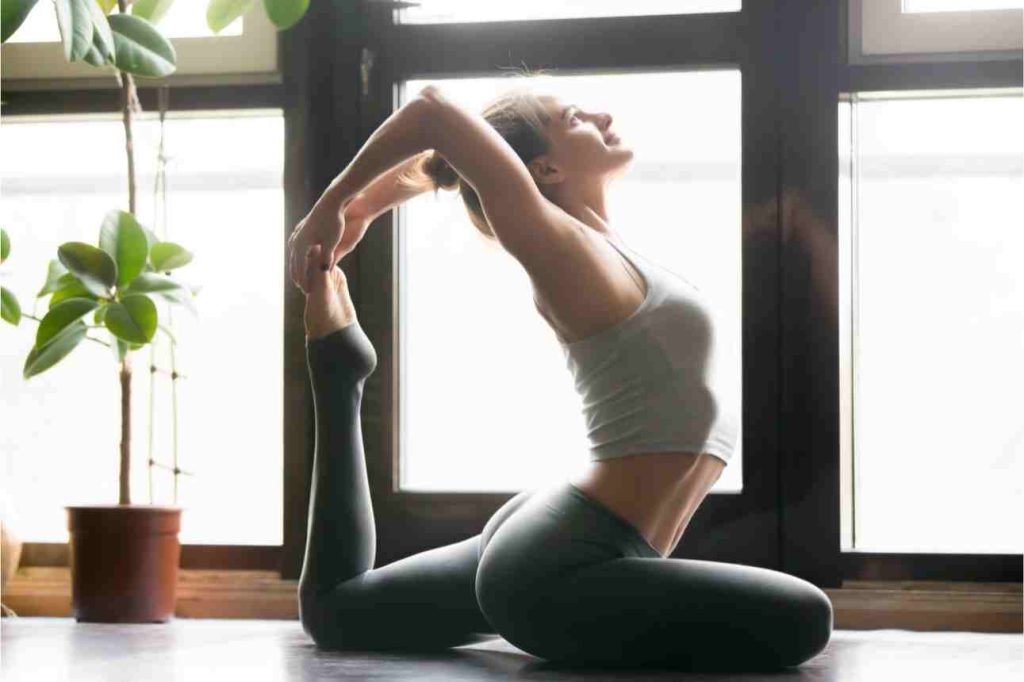
Table of Contents
Rajakapotasana Benefits
In this article, we will discuss the rajakapotasana benefits . First, let’s review what the pose is all about. Then, we’ll talk about the different parts of the body that this pose stretches. You’ll learn how to do the pose correctly, how you should prepare for it, and what to avoid while performing it. In addition, we’ll discuss what to do while performing the pose so you can avoid causing injury.
What is rajakapotasana
If you’ve ever wanted to do seated backbend yoga, you have probably heard about Rajakapotasana. The modern name for this pose is Eka Pada Rajakapotasana, but it is also known as Swan Pose in Yin Yoga and Flying Pigeon in Aerial Yoga. Whatever you call it, you’ll be doing a backbend in your yoga practice.
This backbend yoga pose known as Raja Kapotasana is beneficial for the back and spine. It is also a great stretch for the legs, abs, and front body, and helps to calm the mind. One of the most popular variations of Rajakapotasana is Eka Pada Rajakapotasana.
The posture helps to improve digestion , gently activates lower back muscles. It also strengthens the back and helps alleviate common back problems such as sciatica. This meditative pose can also be beneficial for the immune system, since it calms the nervous system. Although there are a few precautions to take when performing this pose, it can help improve the functionality of your entire body.
In this yoga pose, your body will bend backwards, allowing you to increase your range of motion and increase your flexibility. The back bend also improves the blood flow in the hip region, while the swan pose in yin yoga helps to open the hips. The rajakapotasana benefits are numerous. It also has a calming effect on the nervous system, which may help you overcome stress and anxiety.
How to perform rajakapotasana
Rajakapotasana It can be performed with either left or right foot inside. To perform Eka Pada Rajakapotasana, position yourself on a tabletop. Place your right foot inside the pose. You’ll place your right knee behind your right wrist. Next, you’ll place your left leg backward. Finally, you’ll want to sit with your right hup on the floor, and repeat the position for the other side.
Benefits of performing rajakapotasana
The benefits of performing Rajakapotasana are numerous. Among them are increased flexibility and reduced back pain. The yoga asana also works to stimulate the kidneys and liver. It helps relieve the symptoms of back pain by improving blood flow to them. Another benefit is the relaxation it provides. It is good for people who suffer from anxiety. However, it is not suitable for people who are prone to injuries.
Eka Pada Rajakapotasana is another beneficial asana. It helps improve mental health by releasing negative energy that has built up inside the body. It also increases self-esteem and personal power. It also boosts the sense of purpose and motivates you to do more. In addition to this, performing Rajakapotasana regularly can help improve your physical health.
Precautions while performing rajakapotasana
Rajakapotasana is a common practice and is commonly ordered under extraordinary back bend postures. This article explains the benefits of Rajakapotasana, as well as the precautions and tips involved in performing this asana.
Eka Pada Rajakapotasana is a variation of pigeon pose. This pose opens the hips and causes the chest to puff out. In Sanskrit, ‘eka’ means pigeon. For this reason, it is sometimes called King Pigeon Pose. Before attempting this asana, make sure your back leg is bent and that your shoulders are open.
However, this posture is not recommended for those who have injured or strained back muscles. This yoga posture should not be done on a heavy meal, or if you have a history of back problems.
